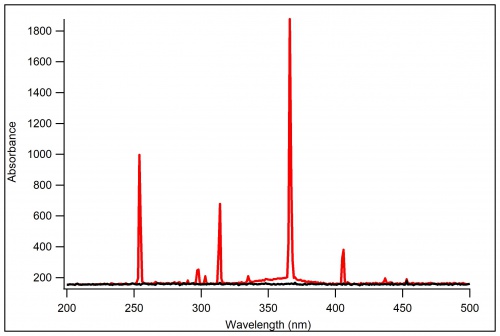Difference between revisions of "Sunglasses UV"
Aangellotti (talk | contribs) |
Aangellotti (talk | contribs) |
||
| (2 intermediate revisions by the same user not shown) | |||
| Line 1: | Line 1: | ||
'''Introduction''' | '''Introduction''' | ||
| − | Sunglasses brands | + | Sunglasses brands claimed that the brand of sunglasses shield human eyes from the U.V. rays that are emitted from the sun better than the competitors. However, the U.V. rays are penetrating but can be stopped by a piece of glass or any plastic object. This experiment investigates whether the different brands of sunglasses protect the eyes from U.V. rays compared to other brands. |
| − | '''Materials''' | + | '''Materials and Procedure''' |
In this experiment, a model UBGL-15 Mineralight Lamp was used to emit the U.V. light. The sunglasses brands that were tested were bears sunglasses, Ferrari sunglasses, minecraft sunglasses, and Monmouth College sunglasses were tested. The setup was a U.V. light source, in this case the Mineralight Lamp, was shown towards the the photodioarry detector which was held on a iron ringstand. The U.V. light sources was first collected and then sunglasses were changed between the detector and photodioarry detector. | In this experiment, a model UBGL-15 Mineralight Lamp was used to emit the U.V. light. The sunglasses brands that were tested were bears sunglasses, Ferrari sunglasses, minecraft sunglasses, and Monmouth College sunglasses were tested. The setup was a U.V. light source, in this case the Mineralight Lamp, was shown towards the the photodioarry detector which was held on a iron ringstand. The U.V. light sources was first collected and then sunglasses were changed between the detector and photodioarry detector. | ||
| Line 40: | Line 40: | ||
| − | '''Result and | + | '''Result and Conclusion |
''' | ''' | ||
The results show that all sunglasses (black line of Figure 1) prevented all of the waves from piecing the sunglasses. This means that all sunglasses, regardless of cost, still prevent the same amount of U.V. rays from penetrating the eyes. The safety glasses did allow for one 400 nm peak to be shown which is due to all the other sunglasses having tinted to reflect out red light. | The results show that all sunglasses (black line of Figure 1) prevented all of the waves from piecing the sunglasses. This means that all sunglasses, regardless of cost, still prevent the same amount of U.V. rays from penetrating the eyes. The safety glasses did allow for one 400 nm peak to be shown which is due to all the other sunglasses having tinted to reflect out red light. | ||
| + | |||
| + | By AJ Angellotti Spring 2019 | ||
Latest revision as of 21:13, 31 January 2019
Introduction
Sunglasses brands claimed that the brand of sunglasses shield human eyes from the U.V. rays that are emitted from the sun better than the competitors. However, the U.V. rays are penetrating but can be stopped by a piece of glass or any plastic object. This experiment investigates whether the different brands of sunglasses protect the eyes from U.V. rays compared to other brands.
Materials and Procedure
In this experiment, a model UBGL-15 Mineralight Lamp was used to emit the U.V. light. The sunglasses brands that were tested were bears sunglasses, Ferrari sunglasses, minecraft sunglasses, and Monmouth College sunglasses were tested. The setup was a U.V. light source, in this case the Mineralight Lamp, was shown towards the the photodioarry detector which was held on a iron ringstand. The U.V. light sources was first collected and then sunglasses were changed between the detector and photodioarry detector.
Result and Conclusion
The results show that all sunglasses (black line of Figure 1) prevented all of the waves from piecing the sunglasses. This means that all sunglasses, regardless of cost, still prevent the same amount of U.V. rays from penetrating the eyes. The safety glasses did allow for one 400 nm peak to be shown which is due to all the other sunglasses having tinted to reflect out red light.
By AJ Angellotti Spring 2019
